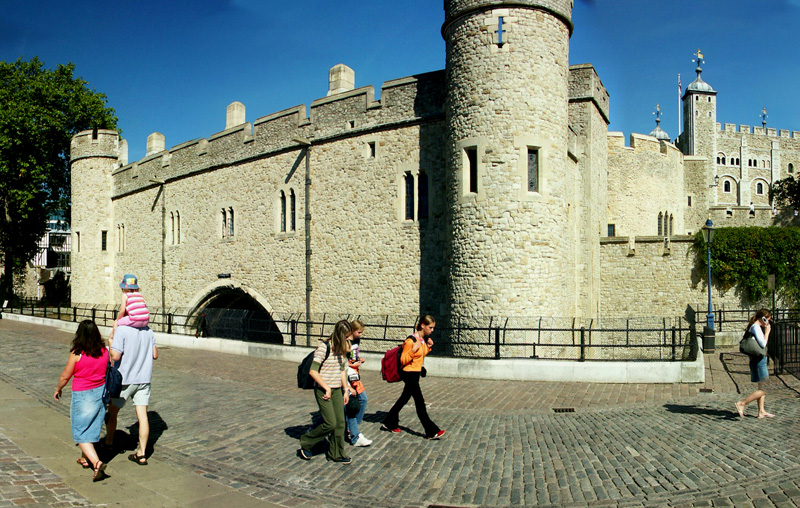
This photo of The Tower of London is part of one of the panoramic images found on the PanoramicEarth.com Tour of London. There are over 100 images taken from around London linked to an interactive map.
London for Less - FREE Theatre, Dining, or Sightseeing . Get the most of London with these London Guide Books
. Get the most of London with these London Guide Books
The Tower of London is another of those London buildings that is a world famous London icon. Built on the north bank of the Thames, opposite to the GLA Headquarters and near to Tower Bridge, the Tower of London evokes visions of imprisonment and torture through the ages of British Monarchy, being a place of execution of not a few kings and queens, along with other notable traitors or prisoners. Entrance to the Tower of London and the surrounding attractions of Tower Bridge Exhibition and the HMS Belfast is free with the London Pass.
Today the Tower of London is mostly known for two things – beheadings and the Crown Jewels. It was here that Anne Boleyn was beheaded by Henry VIII in 1536, supposedly for treason, though most likely for not bearing him a son. Most executions actually occurred on Tower Hill (now the site of a tube station), and only 7 individuals, including Anne Boleyn and Lady Jane Grey, were beheaded on the Tower Green, inside the walls of the Tower of London. The tower has also been a place of plotting and murder, most notably of the 2 sons of Edward IV by Richard, who became Richard III, as written about by Shakespeare. The bones of the 2 boys were discovered many years later under the foot of a stairway.
The Tower of London has long been home to the Crown Jewels. These used to be stored in the White Tower, and were almost successfully stolen by Thomas Blood and his gang in 1671. They were foiled by the unexpected appearance of the son of the guard and the Crown Jewels were saved. For his crimes, bizarrely, Thomas Blood was awarded a £500 per year pension and access to the Royal Court. The Jewels were then moved to a purpose built storeroom, where they remained until the Great Fire in the Tower in 1841. They are now on display in a safely guarded vault.
The central part to the Tower of London is the White Tower (originally called the Great Tower) built by William the Conqueror in 1078. The Tower, constructed of imported French stone, was built to protect both London from outside invasion, and to protect the occupying Normans from London. In the 12C King Richard the Lionheart dug a moat around the Tower and also erected a surrounding wall. This moat was improved in the 13C by Henry III and remained in use until it was drained in 1830. This also finished the effective use of the Tower of London as a fortress.
The Tower of London was converted by Henry III into a royal palace adding a number of outbuildings. Although the Royal Family have not lived here since the times of Oliver Cromwell, the Tower is still guarded as a royal Palace. The Tower has in the past also served time as a zoo, with animals on site from the 13th to the 19th Centuries. The Lion Gate is almost all that remains of this use, which used to be part of the Lion Tower, and the animals moved to the new London Zoo in The Regents Park.
The Tower of London actually contains some 20 distinct towers aside from the central White Tower. These include Beauchamp Tower, Bell Tower, Bloody Tower (or the Garden Tower), Bowyer Tower, Brick Tower, Broad Arrow Tower, Byward Tower, Constable Tower, Cradle Tower, Develin Tower, Deveraux Tower, Flint Tower, Lanthorn Tower, Martin Tower, Middle Tower, St. Thomas's Tower, Salt Tower, Wakefield Tower, Wardrobe Tower and the Well Tower.
Most tourists do not venture much further east than this in London unless they are visiting Greenwich. The nearest tube station to the Tower of London is Tower Hill, which is also an entrance point to the Docklands Light Railway.

The full panoramic image taken of the Tower of London can be found on the London tour by PanoramicEarth.com. An enlargement of this photo can be found on Flickr.
For more articles on London see the London Index or select one of the labels at the bottom.

. Get the most of
2 comments:
There is absolutely no proof that Richard III murdered his nephews in the Tower. In fact he had no reason to kill them as he had been declared king by Lords and Parliament. All that is known is that they were last seen playing in the autumn of 1483. Then they dissapeared. Nobody knows what happened to them. The bones found in the Tower only gave the lie to the Thomas More tale that they had been buried there. The actual age or sex of the bones now in the Abey was never determined, they could be Roman or even Stuart era, and the grave also contained animal bones in it. So this kind of relying on Shakespeare, who was writing drama, for your history, is insulting to a man who was actually shaping up to be one of the best of all medieval monarchs when he was betrayed and killed by a usurpin g bastard (literally) at Bosworth.
whoa...somebody got murdered on the Tower of London? interesting..maybe they just throw the body there but it was not murdered on that place..well don't really know about it..
Post a Comment